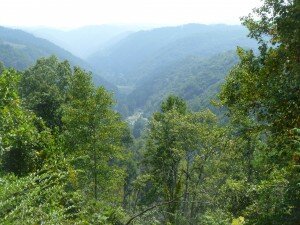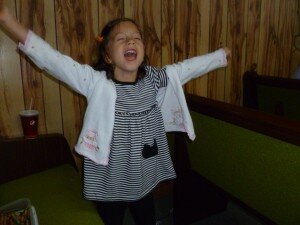Snake handling, part 2
 This is of the Little One standing in front of a famous site in the Shenandoah Valley where there is this huge warehouse of books. Right in the middle of nowhere. The Green Valley Book Fair has intermittent book sales and I've never been able to get there when they were open until Labor Day weekend.OK...we left off at arriving in Grundy, Va., in the middle of nowhere in the western part of the state not far from Breaks Interstate Park on the Tennessee line. Last time I was in that area was in 1977 when I was part of a group biking across America. I met up with the photographer who had spent some time researching folks who handle snakes and plainly, Jolo, West Virginia, is a major gathering spot. Trouble is, it's unbelievably isolated; 420 miles from DC and 22 miles from Grundy up and down a mountain. One comfort: the roads in that part of the country were wonderful. Not a pothole was to be found. None of the photos I took did justice to how pretty the scenery was.
This is of the Little One standing in front of a famous site in the Shenandoah Valley where there is this huge warehouse of books. Right in the middle of nowhere. The Green Valley Book Fair has intermittent book sales and I've never been able to get there when they were open until Labor Day weekend.OK...we left off at arriving in Grundy, Va., in the middle of nowhere in the western part of the state not far from Breaks Interstate Park on the Tennessee line. Last time I was in that area was in 1977 when I was part of a group biking across America. I met up with the photographer who had spent some time researching folks who handle snakes and plainly, Jolo, West Virginia, is a major gathering spot. Trouble is, it's unbelievably isolated; 420 miles from DC and 22 miles from Grundy up and down a mountain. One comfort: the roads in that part of the country were wonderful. Not a pothole was to be found. None of the photos I took did justice to how pretty the scenery was. From the 2,200-foot-high ridge overlooking Jolo, the town appears like a 17th century Italian landscape painting: sandstone cliffs, steep hillsides cloaked with green against distant horizons of romantic, smoky blue ridges. However, once I descend Rt. 83 in low gear, reality bites. Aside from a few nicely kept residences, the rest are a depressing array of homes with cardboard for windows; rows of closed shops and stores and piles of abandoned belongings alongside the road. Once a boomtown thanks to coal, Jolo’s mines tapped out 40 years ago. What’s mostly left are the drugged-out, the unemployed and the retirees. Although there's a new high school down the road, there are no playgrounds in town. McDowell County is dirt poor and number one in ‘domestic migration;’ a nice way of describing the many people who’ve left town.Turning right at the grimy Marathon gas station, which seems to be the only functioning business in town, I drive two miles up the road to the Church of the Lord Jesus, a plain white rectangular building perched on a narrow slip of land on the left side of the road precariously close to a ravine filled with garbage. The gravel parking lot by the church is tiny. I enter the sanctuary which is quite plain. On the left wall of the church near the front is a photo gallery of... people brandishing handfuls of snakes.One photo shows a woman holding what looks like a Coke bottle filled with kerosene oil and a burning wick. She’s holding the flame to her hand; a practice I saw once over the weekend whereby people hold flames to their bodies in obedience to a scriptural verse about one walking through the fire and not being burned. Isaiah 43:2, I think it is. And then there's a verse in Mark 16 about people drinking poison and not being harmed. Sure enough, someone shows me a Mason jar near the pulpit filled with strychnine for the faithful to drink if they feel so moved."It’s a faith that’s worth dying for,” one man solemnly tells me.One of the pastors arrived, carrying a curious-looking wooden box with a lock on it and a glassed-in top with air holes. Within is - you've guessed it - a snake. The reptiles of choice, I'm told are rattlers, water moccasins and copperheads, which is what’s available in the local hills. I joust verbally with him for a few minutes about why he interprets Mark to mean one MUST pick up poisonous snakes to be a faithful Christian. He shows me where he's been bitten four times. People don't necessarily die of snake bites; often it's like getting a hornet's sting, so they tell me. But there are always the exceptions. The Jolo church was founded in 1956 by Bob and Barbara Elkins, he a coal miner and she the mother of six children from a previous marriage. The church was into “signs following,” a scriptural phrase also from Mark that tells insiders that the congregation is open to the miraculous signs listed in Mark: tongues, healing, snakes and poison. But when one of Barbara’s daughters, Columbia, died of snakebite in 1961 at the age of 23, it made the news. The resulting uproar resulted in the state House passing a law making snake handling a crime. Bob Elkins marshaled members of his family to appear before members of the state legislature in Welch, the county seat, to argue they had a religious right to handle snakes. The law never made it out of the state Senate and thus snake handling remains legal in West Virginia.Several other Appalachian states, however, have laws against it. Tennessee has a vague state law prohibiting “a person to display, exhibit, handle, or use a poisonous or dangerous snake or reptile in such manner as to endanger the life or health of any person.” Kentucky specifically outlaws religious snake handling, calls it a misdemeanor and levies $50-$100 fines against it. But the courts rarely take much action because the participants are consenting adults and there’s a ton of religious freedom issues involved. That is, worshippers believe they have a First Amendment right to pick up a snake, drink poison and burn themselves as part of a religious service.Although Barbara died in 1999, Bob died in 2007 and the two are buried just down the road, their legend lives on to the point that a small group of devotees dropped by the spot during the homecoming weekend to pay their respects. Four years later, the sign on the church still has Bob’s name on it as pastor. The current pastor, Harvey Payne, avoids the limelight.One distressing detail about Friday night, which was the kickoff for the homecoming, was the amount of media present. I use "media" loosely as it was mainly a team of folks from Virginia Commonwealth University doing a documentary, the Post's photographer Lauren Pond, someone writing a book and a few other photographers from who-knows-where. But when the snakes were brought out midway through the service, all of them sprang into action, surrounding the snakeholders to a point where the rest of us could barely see what was going on in front.Veeka, by the way, was completely nonplussed by all the snakes. She barely noticed them, preferring to sit in the pew and put to use all the crayons and markers I'd brought with me. Several folks asked me how could I bring a small child to something like this. Well, because a sitter costs $120/day, that's why. I'd heard that pentecostal folks at these services are very protective of the kids and that sure was true. A few times when Veeka would wander up towards the front, all heads swiveled toward me as to warn me she was where she shouldn't be, so I'd scoop her up and take her back to the pew. (The front was where the box of snakes was but honestly, it was only on display for a portion of the service; usually they were tucked in the back somewhere). The Little One really got into the worship and believe me, there was a lot of foot-stompin hymns going on. Sometimes she'd dance about and twirl (see photo) just like all the adults were doing. Well, not her mommy, who sat in the pew taking notes. Other kids came the last day of the homecoming and they looked just as bored as Veeka was.
From the 2,200-foot-high ridge overlooking Jolo, the town appears like a 17th century Italian landscape painting: sandstone cliffs, steep hillsides cloaked with green against distant horizons of romantic, smoky blue ridges. However, once I descend Rt. 83 in low gear, reality bites. Aside from a few nicely kept residences, the rest are a depressing array of homes with cardboard for windows; rows of closed shops and stores and piles of abandoned belongings alongside the road. Once a boomtown thanks to coal, Jolo’s mines tapped out 40 years ago. What’s mostly left are the drugged-out, the unemployed and the retirees. Although there's a new high school down the road, there are no playgrounds in town. McDowell County is dirt poor and number one in ‘domestic migration;’ a nice way of describing the many people who’ve left town.Turning right at the grimy Marathon gas station, which seems to be the only functioning business in town, I drive two miles up the road to the Church of the Lord Jesus, a plain white rectangular building perched on a narrow slip of land on the left side of the road precariously close to a ravine filled with garbage. The gravel parking lot by the church is tiny. I enter the sanctuary which is quite plain. On the left wall of the church near the front is a photo gallery of... people brandishing handfuls of snakes.One photo shows a woman holding what looks like a Coke bottle filled with kerosene oil and a burning wick. She’s holding the flame to her hand; a practice I saw once over the weekend whereby people hold flames to their bodies in obedience to a scriptural verse about one walking through the fire and not being burned. Isaiah 43:2, I think it is. And then there's a verse in Mark 16 about people drinking poison and not being harmed. Sure enough, someone shows me a Mason jar near the pulpit filled with strychnine for the faithful to drink if they feel so moved."It’s a faith that’s worth dying for,” one man solemnly tells me.One of the pastors arrived, carrying a curious-looking wooden box with a lock on it and a glassed-in top with air holes. Within is - you've guessed it - a snake. The reptiles of choice, I'm told are rattlers, water moccasins and copperheads, which is what’s available in the local hills. I joust verbally with him for a few minutes about why he interprets Mark to mean one MUST pick up poisonous snakes to be a faithful Christian. He shows me where he's been bitten four times. People don't necessarily die of snake bites; often it's like getting a hornet's sting, so they tell me. But there are always the exceptions. The Jolo church was founded in 1956 by Bob and Barbara Elkins, he a coal miner and she the mother of six children from a previous marriage. The church was into “signs following,” a scriptural phrase also from Mark that tells insiders that the congregation is open to the miraculous signs listed in Mark: tongues, healing, snakes and poison. But when one of Barbara’s daughters, Columbia, died of snakebite in 1961 at the age of 23, it made the news. The resulting uproar resulted in the state House passing a law making snake handling a crime. Bob Elkins marshaled members of his family to appear before members of the state legislature in Welch, the county seat, to argue they had a religious right to handle snakes. The law never made it out of the state Senate and thus snake handling remains legal in West Virginia.Several other Appalachian states, however, have laws against it. Tennessee has a vague state law prohibiting “a person to display, exhibit, handle, or use a poisonous or dangerous snake or reptile in such manner as to endanger the life or health of any person.” Kentucky specifically outlaws religious snake handling, calls it a misdemeanor and levies $50-$100 fines against it. But the courts rarely take much action because the participants are consenting adults and there’s a ton of religious freedom issues involved. That is, worshippers believe they have a First Amendment right to pick up a snake, drink poison and burn themselves as part of a religious service.Although Barbara died in 1999, Bob died in 2007 and the two are buried just down the road, their legend lives on to the point that a small group of devotees dropped by the spot during the homecoming weekend to pay their respects. Four years later, the sign on the church still has Bob’s name on it as pastor. The current pastor, Harvey Payne, avoids the limelight.One distressing detail about Friday night, which was the kickoff for the homecoming, was the amount of media present. I use "media" loosely as it was mainly a team of folks from Virginia Commonwealth University doing a documentary, the Post's photographer Lauren Pond, someone writing a book and a few other photographers from who-knows-where. But when the snakes were brought out midway through the service, all of them sprang into action, surrounding the snakeholders to a point where the rest of us could barely see what was going on in front.Veeka, by the way, was completely nonplussed by all the snakes. She barely noticed them, preferring to sit in the pew and put to use all the crayons and markers I'd brought with me. Several folks asked me how could I bring a small child to something like this. Well, because a sitter costs $120/day, that's why. I'd heard that pentecostal folks at these services are very protective of the kids and that sure was true. A few times when Veeka would wander up towards the front, all heads swiveled toward me as to warn me she was where she shouldn't be, so I'd scoop her up and take her back to the pew. (The front was where the box of snakes was but honestly, it was only on display for a portion of the service; usually they were tucked in the back somewhere). The Little One really got into the worship and believe me, there was a lot of foot-stompin hymns going on. Sometimes she'd dance about and twirl (see photo) just like all the adults were doing. Well, not her mommy, who sat in the pew taking notes. Other kids came the last day of the homecoming and they looked just as bored as Veeka was. There were a lot more amazing details about the three days I spent in the backwoods of West Virginia that will either appear in the upcoming article (pub date to be determined) or in another post (if this blog's readers really want to read more). Sometimes I felt like I was on another planet, eons away from sophisticated Washington and back in a place where people feel their faith is, yes, worth taking such risks and dying for. I also wondered how the snakes felt, having to listen to hours of country music and all of a sudden - whoosh - they're pulled out of their little boxes and held up in the air. The snakes I saw all looked a bit curious and puzzled; some even looked like they were striking a pose. No doubt they too were bored and happy to be the center of attention.
There were a lot more amazing details about the three days I spent in the backwoods of West Virginia that will either appear in the upcoming article (pub date to be determined) or in another post (if this blog's readers really want to read more). Sometimes I felt like I was on another planet, eons away from sophisticated Washington and back in a place where people feel their faith is, yes, worth taking such risks and dying for. I also wondered how the snakes felt, having to listen to hours of country music and all of a sudden - whoosh - they're pulled out of their little boxes and held up in the air. The snakes I saw all looked a bit curious and puzzled; some even looked like they were striking a pose. No doubt they too were bored and happy to be the center of attention.